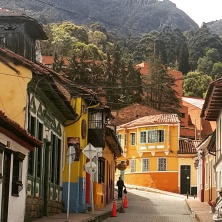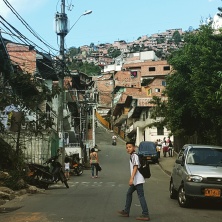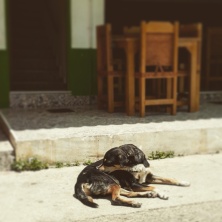
“Why Colombia?” was a question I was often asked by friends when I first mentioned that I would be going there. A few of them raised their eyebrows and gave me a supposedly ‘knowing wink’. (This confused me, since I couldn’t figure out the suggestion in the wink, or what it was I was supposed to know). People I spoke to in Nairobi seemed to know next to nothing about the place, other than that it was a ‘country of drug traffickers, guerrillas and death squads’. Most of my friends had recently seen the Netflix series Narcos, so cinematic scenes of gun battles, bombs and cocaine hauls were pretty much what I was being told to expect. I thought I knew a little bit better. After all, I was familiar with their films and music. I knew about their transitional justice process. I empathised with their struggle. And yes, I had read Márquez.
Eight days in Colombia made me realise how shallow and ignorant I had been, and how two-dimensional my judgement of the country, its violent history, and its place in the world was. Those eight days made me change the lens through which I looked at victims and perpetrators of violence. I had not gone to Colombia expecting my ground to shake. I had not expected to find great wisdom in small places. I did not expect it would redefine my interpretation of justice. And I did not expect so much emotion.
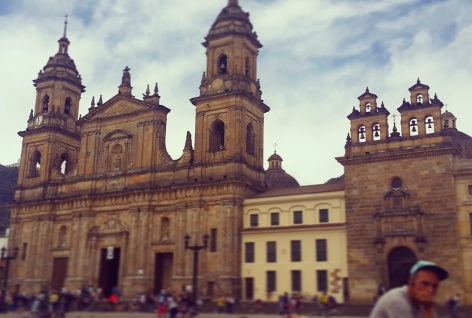
The Viewer
The French political scientist, Dominique Moïsi, has argued that we cannot understand the events of history without considering the role of emotions. Every day of the trip I encountered real-life stories that moved me to places I had tucked away in the parts of my mind that I did not like to visit. Every story seemed to resonate with my own experiences, its much smaller tragedies, its fortunes, and the privilege of peace. Car bombs in Bogotá, young men being forced to join the FARC and ELN, families divided and reunited by conflict and migration. Everyone I met had been affected by violence and they reminisced with passion and resolution, something I would reflected on every evening with similar sentiment. It was becoming quite evident to me that it was emotions that were driving my week. It was emotions that defined how nations and people address their challenges, how they relate to each other, how and when they decided to move on. It’s the heart, not the brain, that decides.

Walking down Bogotá’s history through the streets of La Candelaria, Jorge Cordona Alzate, editor-in-chief of El Espectador and the city guide for the day, transported me through five centuries of chaos and creation. From the founding of the city, the escape and almost assassination of Simón Bolívar, the affair with his mistress, the independence of Gran Colombia, its struggling democracy, the violent 1990s, the attack on the Congress by the M19 militias, and Pablo Escobar. His narration was as authentic as the cobblestones on the street that rolled down towards the Plaza de Bolívar from the church and the Virgin on the hills. The history of Colombia wasn’t a thing of the past for Jorge. It was what has made the present possible. He made me stop to breathe that brisk bogotano air. He wiped clean my pre-conceptions of the country. Like La Candelaria’s graffiti and the street art, his country was a tale of love in a time of conflict. Full of colour; a gallery of pain and hope, of judgement and resilience.
The Prodigal Son
The following day I listened to Paloma Valencia vehemently oppose any possibility of a peace deal between the Colombian government and the FARC rebel movement. How does one forgive a perpetrator? she asked. What kind of justice allows murderers to reap the benefits of peace? It wasn’t her opposition to the peace process that I admired (In fact I disagreed with her), but the passion with which she carried her narrative. A life of violence can have one holding on to unforgiving positions, refusing to budge. A life of violence can also leave one with no option but to compromise. I too would have opposed any suggestion that those who committed crimes should be allowed to go free. I too have equated justice with punishment. Why was I finding her disagreeable when in my own country it would have been me in her chair? Was I being fair?
Those few days listening to several other Colombians punched holes at a theory I have defended in my head on ‘the necessary prerequisites for peace and justice’. I felt conflicted, at times almost aggrieved, that I had never been humble enough to even consider a different view. This country was demonstrating that legal theory doesn’t (always) propagate a society’s healing. Compromise is always a beginning. Perhaps justice isn’t (always) an extract of criminal law.
I recalled watching a Ted Talk on YouTube that week on how Colombia was demobilizing its militants. I watched as the speaker- Jose Miguel Sokoloff- spoke of when they had gone to the jungles to put Christmas lights on trees, in places where they knew the militants would see them. Their message was simple. “If Christmas can come to the jungle you can come home.” Watching that video was the first time I cried that week. It was also the first time I have ever viewed a gun-wielding, killing guerrilla as a human being – who probably wants a way out, a way back to society. It’s a tough debate, on whether a society should go to the lengths and costs of claiming back its lost children, or punish them for their crimes instead. In my heart I knew what would seem right. Don’t the parables talk of a feast at the return of the prodigal son? “If you had one hundred sheep, and lost one of them, wouldn’t you leave the ninety-nine in the wilderness, and go after the one that was lost, until you found it?”
I have since thought of the youth in my country, lost to negative ethnicity and those being recruited into Islamist groups. Have we ever thought of other ways, other than the law school dictates of crime and punishment, to address their atrocities? Have we even attempted to claim back their lives? Is our society already blinded, demanding an eye for an eye?
The Mandala
Popayán was an adventure I had never thought I would live to actually experience. It was the South America I had seen in films, lush with fertile green trees, cathedrals and colonial architecture. Like in a 1980s Michael Douglas movie, we travelled in a bus, meandering on the edges of hills, round narrow roads below the clouds that enveloped the hill tops. We were going to Lerma, a small coca growing village. And my South-American real life movie had a soundtrack too – the flute and drums of school children who greeted us with artful enthusiasm playing hauntingly beautiful old Andean tunes.

Every farm in Lerma was a coca farm, and boy, wasn’t there a lot of it. Coca cookies, coca juice and coca as a vegetable accompaniment with our lunch. It was just a leaf, I realized, nothing like what I had imagined it would be. I found people proudly defending their crop, owning its heritage, its traditional value and its place in their culture. “It was the American peace corps,” they said, “who came to corrupt our people and showed us how to turn our traditional coca into cocaína.”
“It wasn’t me.”
It never is, is it?
The idea that the evil was the work of someone else who comes from somewhere else isn’t new, and I doubted whether their narrative would ever acknowledge the truth that none of the narco trafficking would have happened without their own active and willing participation.
The villagers argued that all the coca they were growing now was for their own use, yet looking around, there seemed to be a bit too much of it just for local consumption. The community in Lerma was warm and kind. They had shown us round their village and invited us into their homes with sincere generosity. I felt uneasy that I wasn’t believing them. Had the lies and disappointments I continuously encounter in my country made me a perennial sceptic? Did I have a cause to doubt that the farmers here were growing their coca for licit use? I wasn’t sure.
The scenery was too beautiful for me to rain on, so I kept my peace. The walk around this very hilly farming community had been tough on my lungs. The farmers, seeing my stocky- self struggling to walk up the rough path, brought me a horse, ‘el caballo’ to help me gallop my way around. I now felt like I was in a proper Western film, riding high like a conquistador, naming and claiming all that was before me. Maybe it was the coca juice doing its thing.
The following day, I met a group women from Ruta Pacifica de las Mujeres, a coalition of feminist groups. They were mostly grassroots organisations advocating for the inclusion of women’s voices in the peace negotiations between the government and FARC rebels. Theirs is a story of mothers, sisters, daughters left behind when the men went out to kill each other. It is of the struggle of women fighting both the patriarchy and glass ceilings of society, and also the burden of picking up the pieces to reconstruct their families and communities after the men have been killed. It is on their backs, and without their acquiescence, that men ventured into the destruction of conflict.
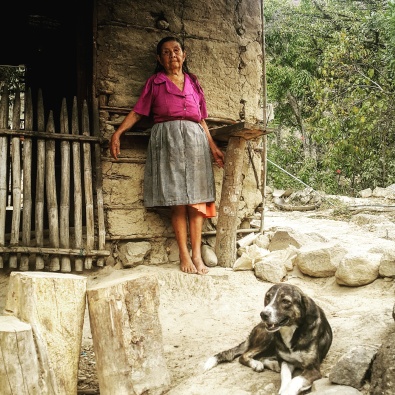
As they spoke, my mind drifted to a favourite Allan Bennet play of mine, The History Boys. Mrs Lintott, one of the play’s characters, laments the place of women in history. “History is a commentary on the various and continuing incapabilities of men,” she says, “What is history? History is women following behind with the bucket.” My eyes went down to the mandala the Ruta Pacificio women had set up in the middle of the room, adorned with pictures, fruits and incense. It told the story of their journey. A spiral of determination, and of Colombia’s real potency; its women and their will to survive.
The Machete Dance
And then there was Medellín, that city of a thousand rooftops rolling down the hillslopes like spattered seeds. I loved the city’s rhythm, its warm climate, its invitation to let loose. It was hard to imagine that this was only until recently the most dangerous place in the world. I fell for its picturesque views, its rich Latin exultations, and its joie de vivre. I daydreamed through its streets, hallucinating that I was in a poncho and sombrero, speaking fluent Spanish.
It was here that I met visual artists, poets and musicians with whom I went on the metrocable to Comuna 13. I felt eerily at home walking around the comuna. The close living quarters, the vibrancy, the working class faces, transported me to the Old Town neighbourhood I grew up in. I imagined that I understood the lives of the people here just by looking at them. I obviously had no idea, but my mind was conjuring up a memory of another place and time.
When I met an Afro-Caribbean band later that day I swayed to the music that was not very different from that from the familiar Indian Ocean islands. That was my catharsis, the old and new worlds meeting in the beat.

The next day, in the hamlet of San Francisco, Antioquia, I re-discovered the living force of oral tradition. The FARC had caused havoc here, displacing villagers, destroying farms. I was welcomed on the hot afternoon for lunch garnished with art, theatre and music. The table was spread with maiz, patata, guayaba y cacao; the offerings of Americá.

Through the sweltering heat and mistranslated conversations, they pulled me in to do ‘the machete dance’, and I found myself in my film again- this time a Colombiano in tempo. The gringo who came in search of Macondo.
#AdiosalaGuerra (farewell to war)
I’m not very good with public emotion. I know that; but every day in Colombia was heavy. So much suffering, so much inequality, so much death, and still so much life and hope. I realised that it was that deep feeling of anger, pain and empathy that makes me do what I do. The world is rife with injustice, and like the shepherd in The Alchemist we seem to journey long distances looking for ourselves. The Everly Brothers could do their crying in the rain. With my brave face and fast mouth, I only had the shower.
I left Colombia a little bit more grown up than when I had arrived.
On August 24th 2016, the Colombian government and the FARC, the largest rebel group in the country, reached a deal in Havana, Cuba, to end 52 years of conflict. It was not the first time the government had attempted to negotiate peace with the rebels. Several previous attempts had failed and there was much skepticism around the negotiations this time round. When the deal was announced, Colombians took to social media to tweet #AdioslaGuerra, “Farewell to war” as they celebrated in the parks in Bogotá, Cali, Catagena and Medellín.
I was already back home by then, but I could feel the excitement and the national exhalation as I watched the announcement on TV. I had been dipped in that water just briefly, and it had made me understand the sacrifice it takes to make peace. Without and within.
You went to Colombia?” another friend asked me when I got back to Nairobi. “Were you not afraid of zika?” “No,” I told him, and gave him a knowing wink.
What matters in life is not what happens to you, Márquez had said, but what you remember and how you remember it. Now I understand what he meant.
